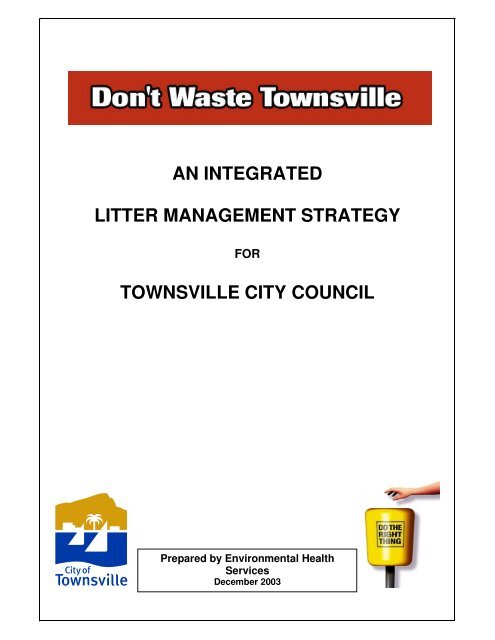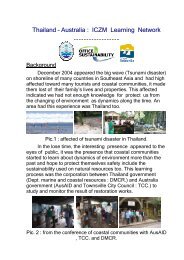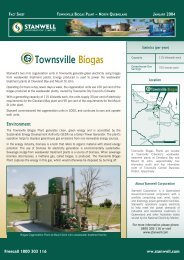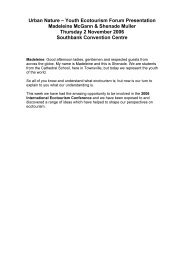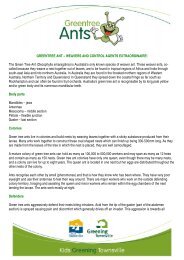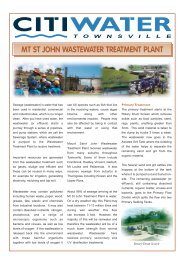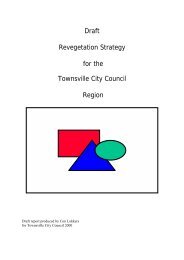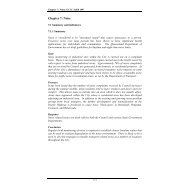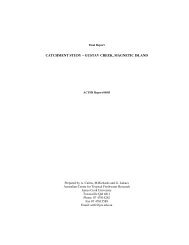an Integrated Litter Management Strategy - Townsville State of the ...
an Integrated Litter Management Strategy - Townsville State of the ...
an Integrated Litter Management Strategy - Townsville State of the ...
Create successful ePaper yourself
Turn your PDF publications into a flip-book with our unique Google optimized e-Paper software.
AN INTEGRATEDLITTER MANAGEMENT STRATEGYFORTOWNSVILLE CITY COUNCILPrepared by Environmental HealthServicesDecember 2003
Table <strong>of</strong> Contents1.0 EXECUTIVE SUMMARY ...................................................................................................................22.0 INTRODUCTION .................................................................................................................................32.1 Why do we need a litter strategy? .................................................................................................32.2 What is <strong>Litter</strong>?...............................................................................................................................32.3 Who <strong>Litter</strong>s?..................................................................................................................................32.4 Why people <strong>Litter</strong>?........................................................................................................................42.5 Where people <strong>Litter</strong>.......................................................................................................................52.6 Why is <strong>Litter</strong> a problem?...............................................................................................................53.0 LITTER LAWS .....................................................................................................................................63.1 Current Legislation........................................................................................................................63.2 Role <strong>of</strong> Enforcement .....................................................................................................................63.3 Penalties ........................................................................................................................................74.0 WHOLE OF COUNCIL APPROACH..................................................................................................84.1 Key Players ...................................................................................................................................84.2 Internal Policies / Procedures ........................................................................................................85.0 LITTER BIN INFRASTRUCTURE AND SERVICES ........................................................................95.1 Review existing situation ..............................................................................................................95.2 Costs..............................................................................................................................................95.3 Establish new st<strong>an</strong>dards for street <strong>an</strong>d park bins.........................................................................105.4 Bin styles for each precinct .........................................................................................................106.0 COUNCIL LITTER REMOVAL ........................................................................................................106.1 Street Sweeping...........................................................................................................................106.2 <strong>Litter</strong> pick up crews.....................................................................................................................116.3 Public Place Recycling................................................................................................................117.0 COMMUNITY INVOLVEMENT ......................................................................................................127.1 Cle<strong>an</strong> up Australia Day ...............................................................................................................127.2 Tidy Towns .................................................................................................................................127.3 Cle<strong>an</strong> beach challenge.................................................................................................................137.4 Adopt a Road...............................................................................................................................138.0 INDUSTRY INVOLVEMENT ...........................................................................................................138.1 Industries that generate problems (customer behaviour).............................................................138.2 Industries which c<strong>an</strong> help ............................................................................................................148.2.1 Beverage Industry Environment Council .................................................................................148.2.2 Keep Australia Beautiful Council ............................................................................................149.0 SPECIAL EVENTS.............................................................................................................................159.1 COMMUNITY EVENTS....................................................................................................................159.2 COUNCIL EVENTS ...........................................................................................................................1510.0 SPECIAL WASTES ..........................................................................................................................1511.0 MARKETING / PROMOTION / EDUCATION ..............................................................................1711.1 Linking with ‘Don’t Waste Australia’.......................................................................................1711.1.1 Logo. ......................................................................................................................................1711.2 Use <strong>of</strong> <strong>an</strong> icon or local celebrity for promotion.........................................................................1811.3 Identify role <strong>of</strong> print <strong>an</strong>d electronic media. ...............................................................................1811.3.1 Editorial..................................................................................................................................1911.3.2 Advertising: Print media ........................................................................................................1911.3.3 Television...............................................................................................................................1911.3.4 Radio ......................................................................................................................................1911.4 Media campaign <strong>an</strong>d news conferences ....................................................................................1911.5 Advertising................................................................................................................................2011.6 <strong>Litter</strong> Prevention Education Kits. ..............................................................................................2011.7 Anti-litter campaigns.................................................................................................................2011.8 Signage......................................................................................................................................2011.9 Web Page. .................................................................................................................................2112.0 ACTION PLANS...............................................................................................................................2113.0 KEY PERFORMANCE INDICATORS............................................................................................2113.1 Qualitative .................................................................................................................................2113.2 Qu<strong>an</strong>titative ...............................................................................................................................2214.0 EVALUATION AND REVIEW .......................................................................................................22Page 1
1.0 EXECUTIVE SUMMARYIn <strong>the</strong> face <strong>of</strong> <strong>the</strong> fast pace <strong>an</strong>d “throw-away mentality” <strong>of</strong> modern society ithas become patently obvious that dated approaches to litter m<strong>an</strong>agementthrough legislation, regulation <strong>an</strong>d reactive cle<strong>an</strong>ups are no longerappropriate.Nationally-based research has shown that <strong>the</strong>re is no one group or section <strong>of</strong>society more prone to litter th<strong>an</strong> o<strong>the</strong>rs. We all contribute in some way to <strong>the</strong>increasing qu<strong>an</strong>tities <strong>of</strong> litter degrading our environment.In a concerted effort to improve environmental outcomes while achievingmaximum benefit from ratepayer funding <strong>Townsville</strong> City Council hasdeveloped <strong>an</strong> <strong>Integrated</strong> <strong>Litter</strong> M<strong>an</strong>agement <strong>Strategy</strong> “Don’t Waste<strong>Townsville</strong>”.The “Don’t Waste <strong>Townsville</strong>” strategy encompasses three prime functions:-• To produce a blueprint for <strong>the</strong> co-ordination <strong>of</strong> litter m<strong>an</strong>agementresources across Council• To ch<strong>an</strong>ge <strong>the</strong> culture <strong>of</strong> <strong>the</strong> <strong>Townsville</strong> community through acomprehensive promotional <strong>an</strong>d educational campaign on litterm<strong>an</strong>agement• To provide a model strategy suitable for adoption on a local, regional<strong>an</strong>d state-wide basis.Based on <strong>the</strong> national “Don’t Waste Australia” campaign sponsored by <strong>the</strong>Beverage Industry Environmental Council this <strong>the</strong>me c<strong>an</strong> be drilled down toindividual locations <strong>an</strong>d events such as “Don’t Waste Our Str<strong>an</strong>d” <strong>an</strong>d “Don’tWaste Skyshow”.This strategy deals with <strong>the</strong> whole r<strong>an</strong>ge <strong>of</strong> litter from <strong>the</strong> usual suspects <strong>of</strong>fast-food <strong>an</strong>d beverage containers through less obvious litter such as cigarettebutts <strong>an</strong>d to emerging litter issues such as discarded syringes. It alsorecognises <strong>the</strong> increasing community awareness <strong>of</strong> diminishing resources <strong>an</strong>daddresses sustainability issues through perm<strong>an</strong>ent public place recycling(3PR) <strong>an</strong>d event recycling for functions sponsored by Council.To promote its message <strong>the</strong> strategy utilises a comprehensive suite <strong>of</strong> mediaincluding television, radio, print media <strong>an</strong>d <strong>the</strong> internet as well as mobilebillboards <strong>an</strong>d illuminated street signs.Recognising that this will be a long-term project <strong>the</strong> strategy incorporates aseries <strong>of</strong> Action Pl<strong>an</strong>s to allow <strong>the</strong> phased completion <strong>of</strong> those elementsrequiring signific<strong>an</strong>t funding commitments.Above all <strong>the</strong> “<strong>Integrated</strong> <strong>Litter</strong> M<strong>an</strong>agement <strong>Strategy</strong> for <strong>Townsville</strong> CityCouncil” recognises that litter m<strong>an</strong>agement is a dynamic issue <strong>an</strong>d that it mustremain as a living document.Page 2
2.0 INTRODUCTION2.1 Why do we need a litter strategy?Throughout Queensl<strong>an</strong>d, <strong>the</strong> approach <strong>of</strong> local governments to litterm<strong>an</strong>agement is inconsistent. Few local governments have <strong>an</strong> overall strategyto address all issues associated with m<strong>an</strong>aging litter generated in <strong>the</strong>ir localarea. While in at least one state, South Australia <strong>the</strong> main thrust against litterhas been <strong>the</strong> implementation <strong>of</strong> container deposit legislation, this approach isseen as being limited only to specific items <strong>of</strong> <strong>the</strong> waste steam; <strong>an</strong>d in <strong>an</strong>ycase is not currently available to Queensl<strong>an</strong>d local government.An effective litter m<strong>an</strong>agement strategy c<strong>an</strong> assist <strong>an</strong>y council to co-ordinateits resources to cost effectively deal with all aspects <strong>of</strong> litter m<strong>an</strong>agement.Cost savings associated with such <strong>an</strong> approach have <strong>the</strong> potential to besignific<strong>an</strong>t.This strategy focuses on litter deposited inappropriately in <strong>the</strong> <strong>Townsville</strong> CityCouncil region, but has been developed with broader objectives in mind. Thisdocument has specifically been designed as a “model” to be rolled out subregionally (eg HESROC–NQ area) or used as a local, regional or statestrategy.2.2 What is <strong>Litter</strong>?Perceptions <strong>of</strong> litter vary, however this strategy considers litter to be allmisplaced solid waste regardless <strong>of</strong> size <strong>an</strong>d material. <strong>Litter</strong> includes but isnot limited to; <strong>an</strong> apple core thrown under bushes, used matchsticks, iceconfection sticks, dog faeces, string, nails, lids <strong>of</strong>f beverage containers,advertising flyers <strong>an</strong>d tissues.Cigarette butts have been identified by surveys <strong>an</strong>d collection staff to be amajor concern, however m<strong>an</strong>y smokers do not consider <strong>the</strong>m to be litter.2.3 Who <strong>Litter</strong>s?Once litter has been defined it is assumed a litterer c<strong>an</strong> be clearly identified asa person who leaves waste in a location without <strong>the</strong> owner’s permission.Identifying a litterer as a particular demographic is more challenging.The results <strong>of</strong> “Underst<strong>an</strong>ding <strong>Litter</strong>ing Behaviour in Australia”, a communitych<strong>an</strong>ge consult<strong>an</strong>t’s report for <strong>the</strong> Beverage Industry Environment Council –shows litterers as a diverse section <strong>of</strong> <strong>the</strong> community. Some <strong>of</strong> <strong>the</strong> findings <strong>of</strong>that report include;1. Australi<strong>an</strong>s <strong>of</strong> all ages (male <strong>an</strong>d female) were more likely to usebins th<strong>an</strong> to litter.2. There are no signific<strong>an</strong>t differences in littering behaviour betweenmales <strong>an</strong>d females.Page 3
3. The people least likely to litter were those aged under 15 years; alladults in all age groups littered more th<strong>an</strong> this group.4. People under 25 years were likely to litter if <strong>the</strong>y were in a group.5. People over 25 years were most likely to litter if <strong>the</strong>y were alone.6. People aged 15 to 24 years had slightly higher littering rates th<strong>an</strong> allo<strong>the</strong>r adults. However, when not in a group, people ages 15 to 24had lower littering rates th<strong>an</strong> o<strong>the</strong>r adults7. Tertiary <strong>an</strong>d post-graduate education was associated with lowerrates <strong>of</strong> littering; primary <strong>an</strong>d secondary education with higher rates<strong>of</strong> littering.8. Full <strong>an</strong>d part-time employment, home duties <strong>an</strong>d retirement wereassociated with lower rates <strong>of</strong> littering; being a student <strong>an</strong>d beingwithout current employment were associated with higher rates.9. There is no clear line between ‘litterers’ <strong>an</strong>d ‘binners’. M<strong>an</strong>y peopleboth littered <strong>an</strong>d used bins in <strong>the</strong> space <strong>of</strong> <strong>an</strong> hour.The diversity <strong>an</strong>d reasonings why litterers litter are m<strong>an</strong>y <strong>an</strong>d varied. Toattempt to reduce litter, it is initially more appropriate to take a broad brushapproach ra<strong>the</strong>r th<strong>an</strong> dealing with <strong>the</strong> specifics.2.4 Why people <strong>Litter</strong>?The act <strong>of</strong> littering c<strong>an</strong> take less th<strong>an</strong> a few seconds <strong>an</strong>d generally is <strong>an</strong>infrequent behaviour. A summary <strong>of</strong> a recent survey showed;1. People were seven times as likely to put beverage containers intobins as <strong>the</strong>y were to litter <strong>the</strong>m.2. People were three times more likely to put newspapers <strong>an</strong>d o<strong>the</strong>rpaper products into a bin as <strong>the</strong>y were to litter <strong>the</strong>m.3. On <strong>the</strong> o<strong>the</strong>r h<strong>an</strong>d, people were three times as likely to litter acigarette, as <strong>the</strong>y were to put one into a bin.4. Of those interviewed, 7% said that <strong>the</strong>y did not consider thatcigarette butts were litter. However, 87% <strong>of</strong> people who littered acigarette said that <strong>the</strong>y did think that cigarette butts were litter.5. M<strong>an</strong>y people put some types <strong>of</strong> objects in bins but littered o<strong>the</strong>rthings; most <strong>of</strong>ten, <strong>the</strong>y littered cigarettes but took everything elseto a bin.Everyone has different perceptions regarding litter no doubt drawn from <strong>the</strong>irown life experiences. Bin placement <strong>an</strong>d bin design are contributing factors toPage 4
littering, as are bins placed in inappropriate locations. Bins that are designedto blend with <strong>the</strong> surrounding environment c<strong>an</strong> contribute to <strong>the</strong> communitylittering.2.5 Where people <strong>Litter</strong>To fully underst<strong>an</strong>d a city’s current litter situation, <strong>the</strong> following people <strong>an</strong>dgroups need to be consulted;CommunityCouncil Parks <strong>an</strong>d Gardens M<strong>an</strong>agement, (Parks Services)Waste M<strong>an</strong>agement Services, (Citiwaste – <strong>Townsville</strong>)Environmental Health ServicesCouncil’s Works Department – (Citiworks – <strong>Townsville</strong>)<strong>Litter</strong> concerns raised by <strong>the</strong> above groups in <strong>Townsville</strong> are shown inAppendix One.The major concerns identified in Appendix 1 c<strong>an</strong> be plotted onto a map <strong>of</strong> <strong>the</strong>local government area. The shaded areas on <strong>the</strong> map show <strong>the</strong> similaritieseach department/community group have on littering concerns. Commonareas mentioned by different departments/community groups are consideredas “hotspots” - that is <strong>an</strong> area where <strong>an</strong>ti–littering measures should befocussed. In <strong>Townsville</strong>, <strong>the</strong> three major hotspots found are:1. The Str<strong>an</strong>d - Str<strong>an</strong>d Park2. C.B.D – Flinders Mall3. Woolcock Street – Road-sideThe map identifying <strong>the</strong>se hotspots c<strong>an</strong> be found at Appendix 2.2.6 Why is <strong>Litter</strong> a problem?<strong>Townsville</strong> is a vibr<strong>an</strong>t city but litter clogging our streets is aes<strong>the</strong>ticallydispleasing <strong>an</strong>d is a d<strong>an</strong>ger to our natural environment, as well as placing asignific<strong>an</strong>t cost burden onto our community.<strong>Litter</strong> c<strong>an</strong> be detrimental to our environment. Inappropriate depositing <strong>of</strong> litterreduces <strong>the</strong> aes<strong>the</strong>tic <strong>an</strong>d property values <strong>of</strong> natural <strong>an</strong>d built environments,pollutes waterways <strong>an</strong>d c<strong>an</strong> injure or kill wildlife. Clear plastic is <strong>of</strong> particularconcern in <strong>the</strong> marine environment where it c<strong>an</strong> be mistaken for food.It has been established that a small number <strong>of</strong> citizens believe certain objectsare not deemed as litter. For example some people do not believe dropping abeverage container tab or a cigarette butt is classed as littering.<strong>Litter</strong> is a fin<strong>an</strong>cial impost. The more residents litter, <strong>the</strong> more it costs <strong>the</strong>local government to cle<strong>an</strong> up. These costs in turn are borne directly byresidents <strong>of</strong> <strong>the</strong> area.Page 5
3.0 LITTER LAWS3.1 Current LegislationIn Queensl<strong>an</strong>d litter is legislated under <strong>the</strong> Environmental Protection (WasteM<strong>an</strong>agement) Regulations 2000. Part 2 – <strong>Litter</strong> <strong>an</strong>d Related Matters defines“litter” as <strong>an</strong>ything that is disposed <strong>of</strong> unlawfully <strong>an</strong>d which is less th<strong>an</strong> 20Litres in volume. <strong>Litter</strong> is said to be unlawfully disposed <strong>of</strong>, unless:• It is disposed <strong>of</strong> at a place by a person who is <strong>the</strong> occupier <strong>of</strong> that place• The disposal is carried out with <strong>the</strong> consent <strong>of</strong> <strong>the</strong> occupier• It is disposed <strong>of</strong> in a litter binWaste in qu<strong>an</strong>tities greater th<strong>an</strong> 20 litres that is not disposed <strong>of</strong> in <strong>the</strong> m<strong>an</strong>nerabove is not classified as “litter” but is referred to as “waste dumping”.• The definition <strong>of</strong> “disposes” includes <strong>an</strong> array <strong>of</strong> ways litter or wastecould be disposed <strong>of</strong>. (Regulation 6)• An <strong>of</strong>fence is created in Regulation 8 for a person unlawfully disposing<strong>of</strong> litter at a place.• An <strong>of</strong>fence is created in Regulation 9 for a person unlawfully disposing<strong>of</strong> more th<strong>an</strong> 20 litres <strong>of</strong> waste at a place.• A maximum penalty is created in Regulation 9 for unlawful disposal <strong>of</strong>more th<strong>an</strong> 200 litres <strong>of</strong> waste.• The regulation sets a defence to <strong>an</strong>y charge listed above if <strong>the</strong> personc<strong>an</strong> show:o That <strong>the</strong>y took all reasonable <strong>an</strong>d practicable measure toprevent <strong>the</strong> disposal,o A reasonable excuse for <strong>the</strong> disposal3.2 Role <strong>of</strong> EnforcementAction requests regarding litter received by Local Government are referred toEnvironmental Health Departments for action. If owners c<strong>an</strong> be identified, <strong>an</strong>investigation is carried out by ei<strong>the</strong>r a Local Laws Officer or EnvironmentalHealth Officer. If <strong>the</strong> <strong>of</strong>fender or owners <strong>of</strong> <strong>the</strong> litter c<strong>an</strong>not be identified,arr<strong>an</strong>gements are made to have it removed to Council’s l<strong>an</strong>dfill.Before a prosecution or a penalty notice c<strong>an</strong> be issued, sufficient informationneeds to be collected to show clearly that <strong>an</strong> <strong>of</strong>fence has occurred <strong>an</strong>d that aparticular person has committed that <strong>of</strong>fence.Unless <strong>the</strong> <strong>of</strong>fender is caught in <strong>the</strong> act, it is very difficult, (although notimpossible) to take fur<strong>the</strong>r action. The evidence required to prove <strong>the</strong> <strong>of</strong>fenceincludes details <strong>of</strong> <strong>the</strong> person found to be littering; name, address, location <strong>of</strong>litter, registration number <strong>of</strong> vehicle (if applicable), photograph <strong>of</strong> litter orwaste being deposited, details <strong>of</strong> <strong>an</strong>y witnesses, sample <strong>of</strong> material.Environmental Health Officers <strong>an</strong>d Local Laws Officers will require delegatedauthority to issue notices under <strong>the</strong> Environmental Protection Act 1994 <strong>an</strong>d bePage 6
issued with Penalty Infringement Notice books for this purpose. TheInstrument <strong>of</strong> Appointment for <strong>Townsville</strong> City Council Local Law Officers isattached at Appendix 3 <strong>an</strong>d includes a section under <strong>the</strong> EnvironmentalProtection Regulations giving delegation to <strong>of</strong>ficers to enforce this component<strong>of</strong> <strong>the</strong> legislation.Enforcement <strong>of</strong> this legislation as a single or total approach to litterm<strong>an</strong>agement is possible but somewhat impractical given <strong>the</strong> limitations listedabove. An educative model in conjunction with <strong>an</strong> enforcement component isbetter suited to achieving <strong>the</strong> desired outcome.3.3 PenaltiesThe maximum penalty for littering under Part 2 <strong>of</strong> <strong>the</strong> EnvironmentalProtection (Waste M<strong>an</strong>agement) Regulations 2000 for :• A littering <strong>of</strong>fence is 20 penalty units. ($1500.00)• Waste dumping between 20 litres <strong>an</strong>d 200 litres is 40 penaltyunits ($3000.00)• Waste dumping over 200 litres is 165 penalty units ($12,375.00)These maximum fines are at <strong>the</strong> discretion <strong>of</strong> <strong>the</strong> court system. Officerswould be required to investigate <strong>the</strong> complaint, ga<strong>the</strong>r information <strong>an</strong>d compilea report on <strong>the</strong>ir findings including a recommendation on appropriate action tobe undertaken in relation to a littering <strong>of</strong>fence. Council would be required toaccept <strong>the</strong> recommendation <strong>an</strong>d institute its own legal proceedings for thismatter to be heard <strong>an</strong>d ruled on in a Magistrates Court.The <strong>State</strong> Penalties Enforcement Act <strong>an</strong>d Regulations allows <strong>an</strong>o<strong>the</strong>ralternative to <strong>the</strong> court system, where a number <strong>of</strong> <strong>of</strong>fences c<strong>an</strong> be dealt withby <strong>the</strong> issue <strong>of</strong> Penalty Infringement Notices (PIN). Schedule 2 <strong>of</strong> <strong>the</strong>regulations sets <strong>the</strong> penalty units applicable for <strong>of</strong>fences under <strong>the</strong>Environmental Protection (Waste M<strong>an</strong>agement) Regulations 2000. Eachpenalty unit is currently worth $75.00.S.8 Offence A person must not unlawfully dispose<strong>of</strong> litter at a placeS.9 Offence For <strong>an</strong> unlawful disposal <strong>of</strong> between20 litres <strong>an</strong>d 200 litres <strong>of</strong> wasteS.9 Offence For <strong>an</strong> unlawful disposal <strong>of</strong> more th<strong>an</strong>200 litres <strong>of</strong> waste2 penalty units4 penalty units16.5 penalty unitsTherefore, littering <strong>of</strong>fences c<strong>an</strong> be dealt with in two ways; by <strong>the</strong> issuing<strong>of</strong> a PIN or by complaint <strong>an</strong>d summons after appropriate investigation <strong>an</strong>dreport to Council.Page 7
4.0 WHOLE OF COUNCIL APPROACH4.1 Key PlayersAs litter affects m<strong>an</strong>y different departments <strong>of</strong> a council, it is essential for alldepartments, business units <strong>an</strong>d sections to fully underst<strong>an</strong>d <strong>the</strong>ir roles <strong>an</strong>dresponsibilities in litter m<strong>an</strong>agement to ensure <strong>the</strong> best use <strong>of</strong> resources.Only when <strong>the</strong> full extent <strong>of</strong> litter control is known within Council c<strong>an</strong> a pl<strong>an</strong> bedetermined to co-ordinate <strong>an</strong>d integrate <strong>the</strong> activities <strong>of</strong> all departments tosolve <strong>the</strong> single issue <strong>of</strong> litter.The pl<strong>an</strong> must consider <strong>the</strong> linkages between sections within Council tominimise costly duplication <strong>of</strong> services <strong>an</strong>d missed services, <strong>an</strong>d to alloweconomy <strong>of</strong> scale operations to occur.The key players include;• Waste m<strong>an</strong>agement section or contractor (street litter bins, litteron streets <strong>an</strong>d roads, cle<strong>an</strong> up <strong>of</strong> spills etc)• Parks <strong>an</strong>d Gardens services (parks, reserves, public openspaces)• Property Services (Council buildings <strong>an</strong>d provision <strong>of</strong> technicalsupport)• Works department (Council controlled roads <strong>an</strong>d drains,programmed <strong>an</strong>d responsive street sweeping)• Contractors (engaged to deal with litter)• Environmental Health (enforcement)• Pl<strong>an</strong>ning <strong>an</strong>d development (Infrastructure requirementsassociated with development)• Heritage Officer / Urb<strong>an</strong> design (litter bin design <strong>an</strong>d placement,heritage values)• Environmental M<strong>an</strong>agement (natural area m<strong>an</strong>agement, creeks<strong>an</strong>d waterways)All key players have a visible <strong>an</strong>d viable part to play in litter m<strong>an</strong>agement;however co ordination <strong>of</strong> hum<strong>an</strong> as well as fin<strong>an</strong>cial resources is paramount.4.2 Internal Policies / ProceduresCouncil c<strong>an</strong> develop policies at both political <strong>an</strong>d operational levels.The political policy acknowledges high level policy direction <strong>an</strong>d outlines <strong>the</strong>direction <strong>of</strong> <strong>the</strong> elected council in dealing with litter as a strategic issue.The policy at <strong>an</strong> operational level is a blueprint for operational staff. It links inwith <strong>the</strong> corporate pl<strong>an</strong> for higher level operational direction <strong>an</strong>d <strong>the</strong> budgetwhich gives fin<strong>an</strong>cial resources to m<strong>an</strong>aging litter.Corporate pl<strong>an</strong>s are renewed each five years <strong>an</strong>d set general direction <strong>of</strong>Council. Operational pl<strong>an</strong>s are developed in line with <strong>the</strong> budget each yearPage 8
<strong>an</strong>d undergo regular reviews. Operational pl<strong>an</strong>s are a road map for achieving<strong>the</strong> outcomes identified in <strong>the</strong> corporate pl<strong>an</strong>. Budgets are developed eachyear <strong>an</strong>d like <strong>the</strong> operational pl<strong>an</strong>s undergo a three monthly review.Operational pl<strong>an</strong>s require perform<strong>an</strong>ce indicators to determine if <strong>the</strong> outcomesare being achieved.5.0 LITTER BIN INFRASTRUCTURE AND SERVICES5.1 Review existing situationBefore <strong>an</strong>y detailed <strong>an</strong>alysis c<strong>an</strong> be undertaken, signific<strong>an</strong>t “base line” dat<strong>an</strong>eeds to be determined.The number <strong>of</strong> litter bins within <strong>the</strong> town / cityThe number <strong>of</strong> bins within each suburbThe size <strong>of</strong> each binThe frequency <strong>of</strong> its collection.The amount <strong>of</strong> litter in <strong>the</strong> bin when it is collected.The location <strong>of</strong> each bin.Placement <strong>of</strong> bins onto a geographic information system.The condition <strong>of</strong> each binThe estimated life <strong>of</strong> each bin.The remaining life <strong>of</strong> each bin.Annual budget allocation for litter bins.The mapping <strong>of</strong> this data onto a GIS will allow information for each bin to bestored within <strong>the</strong> system <strong>the</strong>refore providing a good m<strong>an</strong>agement tool form<strong>an</strong>aging <strong>the</strong>se assets.5.2 CostsBin prices r<strong>an</strong>ge from $70.00 for <strong>the</strong> supply <strong>of</strong> a st<strong>an</strong>dard 240 litre wheelie binto several thous<strong>an</strong>ds <strong>of</strong> dollars for elaborate bin enclosures similar to thatcurrently in use on <strong>Townsville</strong>’s Str<strong>an</strong>d.The life expect<strong>an</strong>cy <strong>of</strong> conventional litter bins is approximately three to fiveyears. To ensure effective m<strong>an</strong>agement <strong>of</strong> <strong>the</strong>se assets, a full cost pricingmodel should be used to evenly spread <strong>the</strong> expenditure on litter bins over<strong>the</strong>ir effective life. From <strong>the</strong>se figures <strong>an</strong> <strong>an</strong>nual replacement cost c<strong>an</strong> becalculated for budget purposes.A detailed <strong>an</strong>alysis <strong>of</strong> litter bins in <strong>the</strong> <strong>Townsville</strong> City Council area iscontained in Appendix 4.<strong>Litter</strong> bin locations throughout <strong>Townsville</strong> are mapped at Appendix 5.Page 9
5.3 Establish new st<strong>an</strong>dards for street <strong>an</strong>d park binsHotspot <strong>an</strong>alysis <strong>of</strong> existing public place litter bins will identify <strong>the</strong> optimallocation for litter bins. In m<strong>an</strong>y cases, it may well determine that <strong>the</strong> existingsites are not <strong>the</strong> best suited for litter m<strong>an</strong>agement. Bin replacement <strong>an</strong>drelocation should follow to maximise <strong>the</strong> effects <strong>of</strong> <strong>the</strong> new bins <strong>an</strong>d newlocations.Such <strong>an</strong> <strong>an</strong>alysis was carried out in <strong>the</strong> <strong>Townsville</strong> Central Business District.Existing litter bins were plotted on a map <strong>an</strong>d new bin locations were overlaidagainst <strong>the</strong>m. (Appendix 6). The number <strong>of</strong> litter bins determined was lessth<strong>an</strong> that currently in use. In <strong>Townsville</strong>, it was also agreed to introduceperm<strong>an</strong>ent public place recycling (3PR) bins. Five 3PR bins have beenlocated within <strong>the</strong> Central Business District in conjunction with litterbins <strong>an</strong>dare being monitored for <strong>the</strong>ir use. It is intended to roll out Perm<strong>an</strong>ent PublicPlace Recycling bins in high pr<strong>of</strong>ile areas such as <strong>the</strong> Str<strong>an</strong>d, Flinders StreetEast <strong>an</strong>d Gregory Street as resources permit.New bins are also being br<strong>an</strong>ded with appropriate signage. The signage willclearly show which bins are public place recycling bins. The signs are clear<strong>an</strong>d colourful <strong>an</strong>d link in with <strong>the</strong> “Don’t Waste Australia” national campaign,which has been localised to a “Don’t Waste <strong>Townsville</strong>” <strong>the</strong>me. Signage alsoincorporates <strong>the</strong> “Do <strong>the</strong> right thing” logo as this br<strong>an</strong>ding was part <strong>of</strong> a verysuccessful previous litter m<strong>an</strong>agement campaign.Examples <strong>of</strong> each sign c<strong>an</strong> be seen at Appendix 7.5.4 Bin styles for each precinctBin design for each precinct enh<strong>an</strong>ces <strong>the</strong> character <strong>of</strong> <strong>the</strong> particular area.Bin enclosures should be designed following consultation with a combination<strong>of</strong> Urb<strong>an</strong> Designers, Parks <strong>an</strong>d Gardens section, Waste contractor,Environmental Health, Environmental M<strong>an</strong>agement, Works department <strong>an</strong>dlocal councillors. All have valuable contributions to <strong>the</strong> process to considerprior to implementation. Such considerations include <strong>the</strong> style, appear<strong>an</strong>ce,placement, positioning, usability, ease <strong>of</strong> cle<strong>an</strong>ing <strong>an</strong>d service, initial purchase<strong>an</strong>d replacement costs.<strong>Townsville</strong> initially purchased <strong>an</strong>d has developed a number <strong>of</strong> precinctdesigned bins. These c<strong>an</strong> be found at Appendix 8.6.0 COUNCIL LITTER REMOVALCouncil removes litter in a number <strong>of</strong> different areas <strong>an</strong>d through a variety <strong>of</strong>processes.6.1 Street SweepingThe sweeping <strong>of</strong> main thoroughfares <strong>an</strong>d footpaths is seen as <strong>an</strong>enh<strong>an</strong>cement <strong>of</strong> our city’s environmentally cle<strong>an</strong> image. Sweeping alsoremoves material from <strong>the</strong> road which could o<strong>the</strong>rwise end up in our rivers<strong>an</strong>d waterways.Page 10
Citiwaste supervises several signific<strong>an</strong>t contracts for cle<strong>an</strong>ing <strong>of</strong> pedestri<strong>an</strong>malls, selected footpaths, Central Business District, major arterial roads <strong>an</strong>dcity approaches.Mech<strong>an</strong>ical sweeping carried out by Citiworks as preventive mainten<strong>an</strong>ce fortraffic safety, or in association with pavement repair also plays a signific<strong>an</strong>trole in litter m<strong>an</strong>agement.6.2 <strong>Litter</strong> pick up crews<strong>Litter</strong> crews are employed in a number <strong>of</strong> departments within Council.Approximately 80 Parks Services employees spend over 200 hours per weekin litter removal. A fur<strong>the</strong>r nine <strong>of</strong>ficers are employed full time with Citiwasteto remove litter from streets, roads etc.It is estimated that in <strong>Townsville</strong> a total <strong>of</strong> over 500 hours per week is spent inlitter removal <strong>an</strong>d control.6.3 Public Place RecyclingSignific<strong>an</strong>t attention has been placed on promoting recycling in <strong>the</strong> home,however when residents leave <strong>the</strong> home, <strong>the</strong>re is no opportunity to continuethat recycling <strong>the</strong>me. In order to support <strong>the</strong> continuing involvement <strong>of</strong> acommunity committed to <strong>the</strong> principles <strong>of</strong> waste minimisation <strong>an</strong>d reduction, <strong>an</strong>atural progression is <strong>the</strong> introduction <strong>of</strong> a public place recycling scheme,both in selected perm<strong>an</strong>ent locations <strong>an</strong>d in conjunction with high-pr<strong>of</strong>ileevents.6.4 Urb<strong>an</strong> Storm Water Quality M<strong>an</strong>agement Pl<strong>an</strong>Council has also developed <strong>an</strong> Urb<strong>an</strong> Stormwater Quality M<strong>an</strong>agement Pl<strong>an</strong>(USQMP) to identify <strong>an</strong>d protect <strong>the</strong> environmental values <strong>of</strong> streams,drainage lines <strong>an</strong>d wetl<strong>an</strong>ds in <strong>the</strong> <strong>Townsville</strong> area <strong>an</strong>d which is integratedwith catchment-based pl<strong>an</strong>ning <strong>an</strong>d l<strong>an</strong>d use pl<strong>an</strong>ning.Stormwater c<strong>an</strong> become polluted if it picks up chemicals <strong>an</strong>d litter from itscatchment <strong>an</strong>d when contaminated stormwater flows into receiving waters ithas <strong>the</strong> potential to adversely affect <strong>the</strong> environmental quality <strong>of</strong> those aquaticenvironments. Urb<strong>an</strong> catchments are particularly problematic due to <strong>the</strong>proximity <strong>of</strong> stormwater drainage systems to sources <strong>of</strong> pollution, such as oil<strong>an</strong>d grease from roads, litter, sediment <strong>an</strong>d o<strong>the</strong>r pollut<strong>an</strong>ts from domestic,commercial <strong>an</strong>d industrial activities, which c<strong>an</strong> enter <strong>the</strong> drainage system.The USQMP provides <strong>the</strong> city with a guide to m<strong>an</strong>aging activities which c<strong>an</strong>reduce <strong>the</strong> impact <strong>of</strong> stormwater on aquatic <strong>an</strong>d ripari<strong>an</strong> habitats. Amongsto<strong>the</strong>r things it includes protection <strong>of</strong> environmental values <strong>of</strong> drainage lines<strong>an</strong>d receiving waters <strong>an</strong>d cost-effective measures to minimise contamination<strong>of</strong> receiving waters, <strong>an</strong>d provides <strong>an</strong> order <strong>of</strong> priority for drainage mainten<strong>an</strong>ce<strong>an</strong>d improvement works.In specific relation to litter m<strong>an</strong>agement <strong>the</strong> USQMP is a valuable aide in <strong>the</strong>pl<strong>an</strong>ning <strong>an</strong>d design <strong>of</strong> new infrastructure, including minimising ecologicalPage 11
impacts on waters in <strong>the</strong> locality, acceptable health risks, aes<strong>the</strong>tics, publicperception <strong>an</strong>d o<strong>the</strong>r social issues. Examples such as Louisa Creek, TheLakes, Ross Creek <strong>an</strong>d Ross River, <strong>an</strong>d <strong>the</strong> Str<strong>an</strong>d provide opportunities tobuild contamin<strong>an</strong>t control measures, <strong>an</strong>d to re-establish ripari<strong>an</strong> vegetation<strong>an</strong>d aes<strong>the</strong>tically pleasing environments where drainage corridors havebecome degraded.7.0 COMMUNITY INVOLVEMENT7.1 Cle<strong>an</strong> up Australia DayCle<strong>an</strong> up Australia Day is <strong>the</strong> nation’s largest community basedenvironmental event. It revolves around a number <strong>of</strong> days each year tocle<strong>an</strong> litter up from our environment. They include a “Business cle<strong>an</strong> upday”, “Schools cle<strong>an</strong> up day” <strong>an</strong>d <strong>the</strong> “Cle<strong>an</strong> up Australia day” <strong>an</strong>d in<strong>Townsville</strong> <strong>the</strong> Magnetic Isl<strong>an</strong>d community has established “Cle<strong>an</strong> upMaggie in Mid winter”.Recent events have highlighted cigarette butts as a signific<strong>an</strong>t litter typewhich is worthy <strong>of</strong> fur<strong>the</strong>r consideration <strong>an</strong>d pl<strong>an</strong>ning for m<strong>an</strong>agement.Cle<strong>an</strong> Up Australia Day is a community event <strong>an</strong>d as such, m<strong>an</strong>agement<strong>of</strong> <strong>the</strong> day is primarily by a community group. Council plays a signific<strong>an</strong>trole in assisting <strong>the</strong> coordinating group to org<strong>an</strong>ise <strong>the</strong> day, remove <strong>the</strong>waste, assist in a supporting role <strong>an</strong>d <strong>the</strong>n donating <strong>the</strong> costs <strong>of</strong> thissupport.Fur<strong>the</strong>r information is available on <strong>the</strong> “Cle<strong>an</strong> up Australia” website atwww.cle<strong>an</strong>up.com.au7.2 Tidy TownsThe Tidy Towns <strong>the</strong>me <strong>of</strong> "Our Town, Our Home, Our Future" isenthusiastically embraced by Queensl<strong>an</strong>d communities each year as <strong>the</strong>yvie for <strong>the</strong> prestigious title <strong>of</strong> Queensl<strong>an</strong>d's Tidiest Town. Tidy Townsmain objective is to encourage <strong>an</strong>d support communities to effectivelytackle litter problems throughout <strong>the</strong>ir local areas.Keep Australia Beautiful Council Queensl<strong>an</strong>d judges take into accountevery community's geographic, environmental <strong>an</strong>d economiccircumst<strong>an</strong>ces, <strong>an</strong>d assess how efficiently <strong>an</strong>d effectively <strong>the</strong> communityuses <strong>the</strong> resources available to itThe Keep Australia Beautiful Council website is www.kabq.org.auPage 12
7.3 Cle<strong>an</strong> beach challengeThe EPA Cle<strong>an</strong> Beach Challenge is a fun, competitive program to helpkeep Queensl<strong>an</strong>d’s beaches litter free, <strong>an</strong>d to encourage localgovernments <strong>an</strong>d <strong>the</strong>ir communities to work toge<strong>the</strong>r.To earn <strong>the</strong> title <strong>of</strong> Queensl<strong>an</strong>d’s Cle<strong>an</strong>est Beach, a beach communitymust not only be cle<strong>an</strong> <strong>an</strong>d tidy, but be strongly proactive <strong>an</strong>d bestexemplify all aspects <strong>of</strong> <strong>the</strong> EPA Cle<strong>an</strong> Beach Challenge.Keep Australia Beautiful Council Queensl<strong>an</strong>d judges take into accountevery beach's geographic, environmental <strong>an</strong>d economic circumst<strong>an</strong>ces,<strong>an</strong>d assess how efficiently <strong>an</strong>d effectively <strong>the</strong> community uses <strong>the</strong>resources available to it against a r<strong>an</strong>ge <strong>of</strong> criteria.The cle<strong>an</strong>est beach <strong>an</strong>d eight outst<strong>an</strong>ding accomplishment awards arepresented each year. The <strong>Townsville</strong> Str<strong>an</strong>d received <strong>the</strong> ‘CollexResource Conservation <strong>an</strong>d Waste M<strong>an</strong>agement Award’ for both 2002 <strong>an</strong>d2003. This award recognises outst<strong>an</strong>ding accomplishment in resourceconservation <strong>an</strong>d waste m<strong>an</strong>agement. Judges look for evidence <strong>of</strong>community, business <strong>an</strong>d/or local council initiatives in <strong>the</strong> conservation <strong>of</strong>natural resources, <strong>the</strong> recovery <strong>an</strong>d reuse <strong>of</strong> "waste" materials <strong>an</strong>d <strong>the</strong>appropriate disposal <strong>of</strong> non-recyclables.The web site for <strong>the</strong> cle<strong>an</strong> beach challenge c<strong>an</strong> be found on <strong>the</strong> KeepAustralia Beautiful Queensl<strong>an</strong>d website at www.kabq.org.au7.4 Adopt a RoadKeep Australia Beautiful Council Queensl<strong>an</strong>d has established a state-wideAdopt-a-Road program to assist with education about, <strong>an</strong>d <strong>the</strong> fightagainst, roadside litter.The objectives <strong>of</strong> Adopt-a-Road are to provide a safe, enjoyable <strong>an</strong>deducational roadside program that will give local communities <strong>the</strong>opportunity to contribute to a healthier <strong>an</strong>d cle<strong>an</strong>er roadside environment.The program’s purpose is to educate <strong>the</strong> community that littering is asocial <strong>of</strong>fence <strong>an</strong>d <strong>an</strong> unacceptable action.The web site for “Adopt a Road” c<strong>an</strong> be found on <strong>the</strong> Keep AustraliaBeautiful Queensl<strong>an</strong>d website at www.kabq.org.au8.0 INDUSTRY INVOLVEMENT8.1 Industries that generate problems (customer behaviour)Consultation showed a number <strong>of</strong> items found on <strong>the</strong> road side are from fastfood establishments, including food wrappers <strong>an</strong>d drink containers. Fast foodPage 13
establishments have <strong>the</strong> responsibility to ensure <strong>the</strong>ir property is free <strong>of</strong> litterhowever, investigation showed litter from <strong>the</strong>se establishments occurs up to 5km from <strong>the</strong> food establishment.Roads to <strong>an</strong>d from refuse tips contains litter blown from uncovered <strong>an</strong>dunsecured loads. Due to <strong>the</strong> practical difficulties <strong>of</strong> local governmentsregulating litter from moving vehicles, <strong>Townsville</strong> City Council periodicallyengages Queensl<strong>an</strong>d Police to enforce traffic safety provisions on routes to<strong>the</strong> l<strong>an</strong>dfill.8.2 Industries which c<strong>an</strong> help8.2.1 Beverage Industry Environment CouncilThe Beverage Industry Environment Council is <strong>the</strong> peak industryassociation representing <strong>the</strong> environmental interests <strong>of</strong> Australia’s beer,s<strong>of</strong>t drink <strong>an</strong>d leading wine m<strong>an</strong>ufacturers – <strong>an</strong>d <strong>the</strong>ir aluminium, glass<strong>an</strong>d PET packaging suppliers.The Beverage Industry Environment Council also assists with hotspot<strong>an</strong>alysis <strong>an</strong>d provides training packages to educate <strong>an</strong>d train people onlitter bin strategies. This training has been undertaken by a number <strong>of</strong>staff within <strong>Townsville</strong> City Council who have responsibility in placement <strong>of</strong>litter bins.The BIEC web site is www.biec.com.au8.2.2 Keep Australia Beautiful CouncilKeep Australia Beautiful programs motivate people to enh<strong>an</strong>ce <strong>the</strong> quality<strong>of</strong> <strong>the</strong>ir local environment through personal initiative <strong>an</strong>d community action.<strong>Litter</strong> abatement, resource conservation, re-afforestation, l<strong>an</strong>d care,general beautification <strong>an</strong>d increased environmental awareness are <strong>the</strong>natural products <strong>of</strong> KAB programs. Good citizenship, pride <strong>an</strong>dempowerment are <strong>the</strong> positive social outcomes.Their website is www.kabq.org.au8.2.3 Coast CareCoast Care is a Natural Heritage Trust scheme to encourage localcommunities to protect dunes, estuaries <strong>an</strong>d wetl<strong>an</strong>d coastalenvironments. Locally, Coast Care has implemented a Fish Don’t Smokeproject in conjunction with Sunferries. The project aims to make peopleaware <strong>of</strong> <strong>the</strong> five-year life <strong>of</strong> a cigarette butt in <strong>the</strong> marine environment.Ashtrays <strong>an</strong>d signs were installed at Picnic Bay jetty to encourage peopleto ‘bin <strong>the</strong>ir butts’. Effectiveness is to be measured through regularsurveys.Their web site is http://www.ea.gov.au/coasts/coastcare/Page 14
9.0 SPECIAL EVENTSSpecial events like community or cultural events have specific litterrequirements that need to be addressed. <strong>Litter</strong> cle<strong>an</strong>ing <strong>an</strong>d removal mustremain as <strong>an</strong> integral element <strong>of</strong> <strong>the</strong> event org<strong>an</strong>isationSpecial events are becoming more regular <strong>an</strong>d it has been <strong>the</strong> experience <strong>of</strong><strong>the</strong> <strong>Townsville</strong> City Council that maintaining <strong>the</strong> lead agency role with littercollection <strong>an</strong>d removal at <strong>the</strong>se events is costly. <strong>Litter</strong> removal at <strong>the</strong>seevents has now been included as a condition on approvals gr<strong>an</strong>ted by Councilto use public open spaces. Bonds are held to ensure such work issatisfactorily completed.9.1 COMMUNITY EVENTSOne such event where litter reduction <strong>an</strong>d recycling is a signific<strong>an</strong>t component<strong>of</strong> <strong>the</strong> festival is <strong>the</strong> <strong>Townsville</strong> “Eco Fiesta”. More details on how litter ism<strong>an</strong>aged at this event are contained at Appendix 9.9.2 COUNCIL EVENTSAt events wholly sponsored by Council, arr<strong>an</strong>gements for litter m<strong>an</strong>agement<strong>an</strong>d public place recycling are more easily m<strong>an</strong>aged. At Skyshow 2003Council introduced a major event recycling promotion which was extremelysuccessful <strong>an</strong>d involved assist<strong>an</strong>ce from BIEC, Visy <strong>an</strong>d EPA. Recycling <strong>an</strong>dlitter bins were co-located at approximately 277 sites <strong>an</strong>d litter bins were alsolocated at <strong>an</strong>o<strong>the</strong>r 23 sites where recycling bins were not consideredappropriate. All bins were properly identified by signage <strong>an</strong>d several designs<strong>of</strong> “bin caps” were trialled to gauge <strong>the</strong>ir effectiveness.The signific<strong>an</strong>t outcomes <strong>of</strong> this initiative were:• <strong>Litter</strong> not contained in bins was negligible• High number <strong>of</strong> litter <strong>an</strong>d recycling bins increased set-up costs, butreduced cle<strong>an</strong>-up costs <strong>an</strong>d time <strong>an</strong>d environmental impact.• 3.085 Tonnes <strong>of</strong> material was collected• 2.25 Tonnes was contained in litter bins• 0.835 Tonnes was contained in recycling bins <strong>an</strong>d was 27% <strong>of</strong> totalmaterial• Contamination rate <strong>of</strong> recyclate was just 6%Photos <strong>of</strong> Skyshow c<strong>an</strong> be seen at Appendix 10.10.0 SPECIAL WASTESMost <strong>of</strong> us easily recognise “traditional” litter, such as fast-food wrappers,beverage containers, advertising brochures <strong>an</strong>d plastic bags.However those who are involved in applied litter m<strong>an</strong>agement have seensome disturbing additions to <strong>the</strong> list <strong>of</strong> usual litter items.Page 15
10.1 Sharps M<strong>an</strong>agementSharps m<strong>an</strong>agement in public places is becoming <strong>an</strong> increasing issue worthy<strong>of</strong> consideration in <strong>an</strong>y litter m<strong>an</strong>agement strategy. Such pl<strong>an</strong>s c<strong>an</strong> becomestrategies within <strong>the</strong>mselves. They should include;• Known disposal sites.• Location <strong>of</strong> sharps disposal containers for public use (public toilets,participating chemists)• Contact people (<strong>State</strong> <strong>an</strong>d Local Government)• Procedures for collection <strong>an</strong>d disposal10.2 Butt M<strong>an</strong>agementCigarette butts do form a component <strong>of</strong> <strong>the</strong> litter waste stream. Due to <strong>the</strong>irsize, <strong>the</strong>y may need to be considered in a different way to normal streams <strong>of</strong>waste. Work in this area has been conducted by <strong>the</strong> South Australi<strong>an</strong>Government <strong>an</strong>d c<strong>an</strong> be found at www.BUTTsOUT.netObservations have also identified cigarette butts to be a major littering item.This was identified in recent “Cle<strong>an</strong> Up Australia Day” reports. <strong>Townsville</strong> CityCouncil is currently investigating <strong>the</strong> provision <strong>of</strong> “Butt Out” facilities at keylocations <strong>an</strong>d at incorporating provision for cigarette butts in replacement litterbin styles.Page 16
10.3 UnmentionablesThere is <strong>an</strong> increasing r<strong>an</strong>ge <strong>of</strong> o<strong>the</strong>r paraphernalia <strong>an</strong>d discarded items in<strong>the</strong> litter stream which reflect ch<strong>an</strong>ges in leisure activities <strong>an</strong>d lifestyle.Whilst used items such as bongs, foils <strong>an</strong>d condoms do not constitute a highvolume <strong>of</strong> litter <strong>the</strong>y do present additional hazards for both collection staff <strong>an</strong>d<strong>the</strong> general community <strong>an</strong>d require special consideration <strong>an</strong>d strategies.11.0 MARKETING / PROMOTION / EDUCATION11.1 Linking with ‘Don’t Waste Australia’“Do The Right Thing” is <strong>an</strong> iconic Australi<strong>an</strong> environmental campaign firstlaunched in 1979 <strong>an</strong>d widely acclaimed as <strong>the</strong> most successful behaviourch<strong>an</strong>ging campaign in Australi<strong>an</strong> history. The campaign was so effective thattoday, over eleven years since <strong>the</strong> advertisements were last run, Do TheRight Thing as both a br<strong>an</strong>d <strong>an</strong>d a message is inst<strong>an</strong>tly recognised <strong>an</strong>dunderstood by almost all sections <strong>of</strong> <strong>the</strong> Australi<strong>an</strong> community.A second generation “Do The Right Thing” campaign is being re-launched bya national advertising campaign <strong>an</strong>d a series <strong>of</strong> programs that are aimed toactively engage <strong>the</strong> support <strong>of</strong> <strong>the</strong> community in litter education. Thecampaign sees <strong>the</strong> introduction <strong>of</strong> a second complementary <strong>the</strong>me <strong>of</strong> “Don’tWaste Australia”.Linking into <strong>the</strong> national campaign has m<strong>an</strong>y benefits <strong>an</strong>d major cost savings.Local government is being encouraged to participate in this campaign with noup-front costs, however precise “Don’t Waste Australia” specifications apply.These specifications include;11.1.1 Logo.The use <strong>of</strong> a <strong>Townsville</strong> City Council logo on publicity material releasedon a national level by <strong>the</strong> Beverage Industry Environment Council togive <strong>the</strong> campaign a <strong>Townsville</strong> <strong>the</strong>me has been strongly endorsed.The text should be in <strong>the</strong> approved typefaces <strong>an</strong>d colours <strong>an</strong>d mustcarry <strong>the</strong> “Do The Right Thing” br<strong>an</strong>d on <strong>the</strong> bottom right h<strong>an</strong>d corner.Advice from <strong>the</strong> Beverage Industry Environment Council is that o<strong>the</strong>rcities <strong>an</strong>d towns have included <strong>the</strong>ir own logos on <strong>the</strong> bottom leftcorner.11.1.2 Slog<strong>an</strong>The “Don’t Waste Australia” imaging has been designed toaccommodate campaigns similar to what <strong>Townsville</strong> proposes. Thelogo c<strong>an</strong> be localised to apply to high pr<strong>of</strong>ile target areas.“Don’t Waste <strong>Townsville</strong>”Page 17
“Don’t Waste our Parks”“Don’t Waste our Str<strong>an</strong>d”“Don’t Waste our Streets”“Don’t Waste Magnetic Isl<strong>an</strong>d”Copies attached in Appendix 11These slog<strong>an</strong>s conform to <strong>the</strong> national campaign, provide local identityownership <strong>an</strong>d link effectively with <strong>the</strong> national campaign.The slog<strong>an</strong> with minimum effort c<strong>an</strong> be developed to include specificevents, locations or occasions.Eg;“Don’t Waste Hermit Park”“Don’t Waste Corcor<strong>an</strong> Park”“Don’t Waste our Skyshow”“Don’t Waste our Show”More signific<strong>an</strong>tly <strong>the</strong> slog<strong>an</strong> c<strong>an</strong> be adopted <strong>an</strong>d rolled out on a districtor regional basis, such as:“Don’t Waste <strong>the</strong> Dry Tropics”“Don’t Waste <strong>the</strong> Burdekin”“Don’t Waste North Queensl<strong>an</strong>d”“Don’t Waste <strong>the</strong> Barrier Reef”11.2 Use <strong>of</strong> <strong>an</strong> icon or local celebrity for promotion.The national campaign has identified eminent Australi<strong>an</strong>s, sporting heroes<strong>an</strong>d media personalities as “Ambassadors” <strong>an</strong>d it suggests that <strong>the</strong>secelebrities should be used to endorse <strong>the</strong> campaign.However <strong>the</strong> campaign itself has a community focus ra<strong>the</strong>r th<strong>an</strong> celebrityfocus on its promotion. The promotional signs, posters <strong>an</strong>d graphic materialare generic, multicultural <strong>an</strong>d cover all age groups.“Don’t Waste <strong>Townsville</strong>” requires community ownership to be effective, but<strong>Townsville</strong> City Council should be clearly identified as <strong>the</strong> lead agency inbringing it to <strong>the</strong> <strong>Townsville</strong> <strong>an</strong>d community in funding <strong>the</strong> local initiatives <strong>of</strong><strong>the</strong> program.A high pr<strong>of</strong>ile Councillor should be clearly identified with all major publicactivities <strong>an</strong>d promotion <strong>of</strong> “Don’t Waste <strong>Townsville</strong>”. However <strong>the</strong> localcampaign should certainly draw on <strong>the</strong> services <strong>of</strong> suitable national campaign“Ambassadors”, particularly for launches <strong>an</strong>d major events.11.3 Identify role <strong>of</strong> print <strong>an</strong>d electronic media.The media strategy will have two components, editorial (news) <strong>an</strong>dadvertising.Page 18
11.3.1 EditorialLaunch <strong>an</strong>d media releases for milestone events has been produced atsection 11.4.11.3.2 Advertising: Print mediaIt is recommended that newspaper advertising be linked to milestoneevents The most effective format will be feature page/s produced ineditorial style (advertorial). This has a much higher credibility-retentionrate th<strong>an</strong> a st<strong>an</strong>dard advertisement.11.3.3 TelevisionUse <strong>the</strong> national campaign’s television promos tagged with a localsuper. This material is available free <strong>of</strong> charge. However a charge willbe incurred to develop <strong>an</strong>d place <strong>the</strong> super.BIEC advises <strong>the</strong>re is no exclusive television sponsor, but it is knownthat Ch<strong>an</strong>nel 9 is a strong supporter. Television stations will be keen totake up local part-sponsorship deals including on a one-for-one basis.11.3.4 RadioAny radio campaigns must be linked to actual event-launches. Radio is<strong>an</strong> excellent media to motivate attend<strong>an</strong>ce-involvement with day-before<strong>an</strong>d event-day advertisements <strong>an</strong>d <strong>an</strong>nouncer paid-comment.11.4 Media campaign <strong>an</strong>d news conferencesTo achieve maximum benefit from <strong>the</strong> media, <strong>the</strong> following milestones shouldbe used to promote <strong>the</strong> litter strategy:1. Launch <strong>of</strong> “Don’t Waste <strong>Townsville</strong>”Have logo <strong>an</strong>d previews <strong>of</strong> television promos co-ordinated.Invite media <strong>an</strong>d campaign supporters/sponsors including Beverage IndustryEnvironment Council <strong>an</strong>d Do <strong>the</strong> Right Thing Foundation.2. Launch <strong>of</strong> “Don’t Waste <strong>Townsville</strong>” signs / b<strong>an</strong>ners.Invite media with possible appear<strong>an</strong>ce <strong>of</strong> a National “Don’t Waste Australia”Ambassador.3. Media focus on location-specific campaign.Provide signage <strong>an</strong>d invite representatives <strong>of</strong> <strong>an</strong>y community alli<strong>an</strong>cesdeveloped from <strong>the</strong>se campaigns.E.g.“Don’t Waste <strong>the</strong> Mall” (engage CBD traders <strong>an</strong>d o<strong>the</strong>rs)“Don’t Waste our Waterways” (Port Authority <strong>an</strong>d Sunfish)“Don’t Waste our Sporting Venues” (Crocodiles, Fire etc.)4. Mayor to address luncheon meeting <strong>of</strong> Chamber <strong>of</strong> Commerce withmedia coverage. Focus on success <strong>of</strong> national campaign <strong>an</strong>dencourage involvement from commerce <strong>an</strong>d industry.5. Media focus on <strong>an</strong>y community initiatives, spin-<strong>of</strong>fs from <strong>the</strong> campaign.Presentation by Mayor / Councillors <strong>of</strong> awards or certificatesPage 19
6. Media to cover <strong>an</strong>y educational components <strong>of</strong> campaign going intolocal schools11.5 Advertising.Maintain community awareness <strong>of</strong> ‘Don’t waste <strong>Townsville</strong>” through genericTV advertising. Ensure that print media <strong>an</strong>d radio advertising is directly linkedto major media launches <strong>an</strong>d events.11.6 <strong>Litter</strong> Prevention Education Kits.Target at pre-school, primary school <strong>an</strong>d secondary schools.Develop a kit that contains information to all levels <strong>of</strong> <strong>the</strong> education system.The information will need to address <strong>the</strong> level to which it is targeted.This project will require close liaison with state <strong>an</strong>d private school authorities<strong>an</strong>d could also be resourced through <strong>the</strong> national campaign <strong>of</strong>fice. A detailedcosting for this project has not been developed, however a similar projectdeveloped in <strong>the</strong> late 1990’s for a dengue fever education package in schoolscost Council over $20,000. A projected figure for this project based on <strong>the</strong>dengue fever project would be $30,000.00A more urgent priority is a generic “Don’t Waste <strong>Townsville</strong>” <strong>an</strong>ti-litterbrochure suitable for broad public distribution11.7 Anti-litter campaigns.Budget submissions would be required to run specific <strong>an</strong>ti-litter campaigns.Event specific campaigns will require co ordination though Council’s PublicRelations Office for events such as <strong>the</strong> Eco fiesta, Carols by C<strong>an</strong>dlelight, NewYears Eve, Australia Day etc.Large public ga<strong>the</strong>rings including <strong>the</strong> Cultural Fest <strong>an</strong>d <strong>the</strong> Greek Festivalmight be covered under existing local campaigns eg :”Don’t Waste OurStr<strong>an</strong>d” <strong>an</strong>d “Don’t Waste our Parks”.11.8 Signage.A <strong>Townsville</strong> image is currently being developed that will carry <strong>the</strong> “Don’tWaste <strong>Townsville</strong>” <strong>an</strong>d “Do The Right Thing” logos. This image will be usedat all media milestones <strong>an</strong>d at every opportunity to promote litter awareness.Additional signs specific to each events c<strong>an</strong> be considered, however <strong>the</strong>costing <strong>of</strong> <strong>the</strong>se signs should be added into <strong>the</strong> promotion <strong>of</strong> each event.The <strong>Townsville</strong> City Council have utilised identilite street p<strong>an</strong>els as <strong>an</strong>o<strong>the</strong>rmedium to present litter messages to <strong>the</strong> public.Page 20
11.9 Web Page.This entire litter strategy will be placed in <strong>the</strong> <strong>Townsville</strong> City CouncilEnvironmental Health web site. In addition to <strong>the</strong> strategy, all images, slog<strong>an</strong>s,television commercials <strong>an</strong>d <strong>an</strong>y radio commercials developed will be on <strong>the</strong>site. www.townsville.qld.gov.auThe site will also hold all press releases <strong>an</strong>d media articles on <strong>the</strong> campaign<strong>an</strong>d will be hot linked to a host <strong>of</strong> allied <strong>an</strong>d related sites that deal with litterissues including recycling.12.0 ACTION PLANSThe development <strong>of</strong> this strategy has highlighted a number <strong>of</strong> issues for actionby several sections or business units <strong>of</strong> Council.In recognising that <strong>the</strong>se actions may require ei<strong>the</strong>r extended periods <strong>of</strong> timeto complete or <strong>the</strong> allocation <strong>of</strong> additional resources, Action Pl<strong>an</strong>s need to bedeveloped by each department identifying goals, resources, time frames,milestones for completion <strong>an</strong>d key perform<strong>an</strong>ce indicators.The m<strong>an</strong>agement <strong>of</strong> litter is <strong>an</strong> evolving science <strong>an</strong>d it is imperative that thisstrategy <strong>an</strong>d action pl<strong>an</strong>s remain dynamic documents.13.0 KEY PERFORMANCE INDICATORSKey Perform<strong>an</strong>ce indicators are essential to ensure <strong>the</strong> items recommendedin this strategy are successfully addressed. There are two forms <strong>of</strong> KeyPerform<strong>an</strong>ce Indicators:13.1 QualitativeQualitative research is based on attitudes <strong>an</strong>d opinions. Extensive researchhas shown that litter prevention strategies which ch<strong>an</strong>ge community attitudeshave achieved better results th<strong>an</strong> programs focused on litter reduction orcle<strong>an</strong> up <strong>of</strong> litter after <strong>the</strong> event.Consultation <strong>an</strong>d surveys must occur with <strong>Townsville</strong> City Council employeesinvolved in litter cle<strong>an</strong> up to review impact <strong>of</strong> ‘Don’t Waste <strong>Townsville</strong>’campaign on road side litter after twelve months.Page 21
13.2 Qu<strong>an</strong>titativeCouncil’s Waste M<strong>an</strong>agement (Citiwaste) <strong>an</strong>d Parks <strong>an</strong>d Gardens’m<strong>an</strong>agement (Parks Services) will provide qualitative data to determine if <strong>the</strong>amount <strong>of</strong> litter in <strong>the</strong> <strong>Townsville</strong> region has ch<strong>an</strong>ged at nominated pointssince <strong>the</strong> introduction <strong>of</strong> <strong>the</strong> ‘Don’t Waste <strong>Townsville</strong>’ campaign.Hotspot <strong>an</strong>alysis training for staff from Environmental Health Services,Citiwaste <strong>an</strong>d Parks Services is required. This may involve covertobservations <strong>of</strong> people at <strong>the</strong> hotspots to determine percentage <strong>of</strong> peoplelittering. This is especially useful to determine <strong>the</strong> effectiveness <strong>of</strong> <strong>the</strong>recommendations following <strong>the</strong> hotspot <strong>an</strong>alysis.14.0 EVALUATION AND REVIEWIt is recommended this strategy is reviewed by Environmental Health Servicesin December 2004 to ensure recommendations have been addressed <strong>an</strong>deffectively implemented.Page 22


